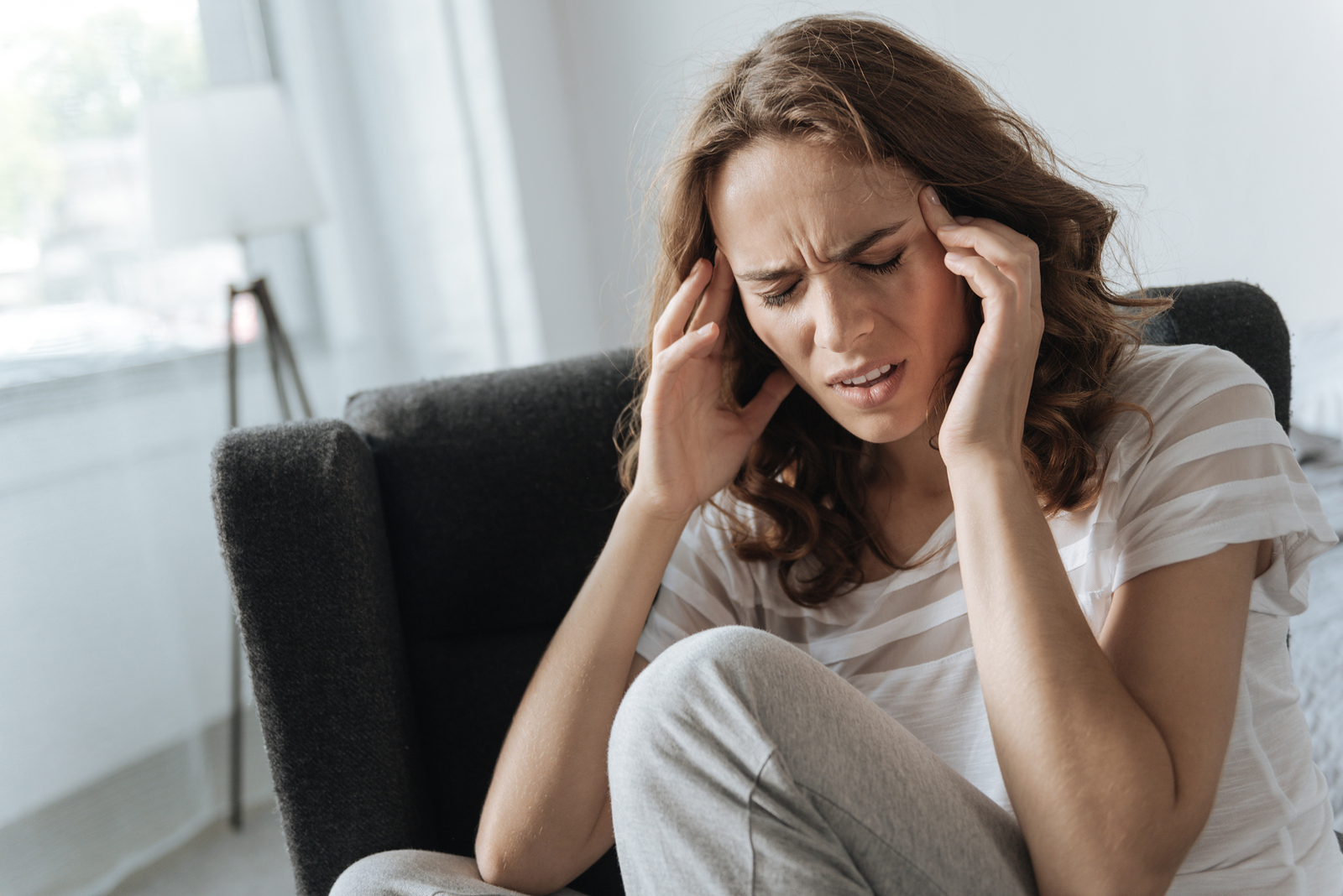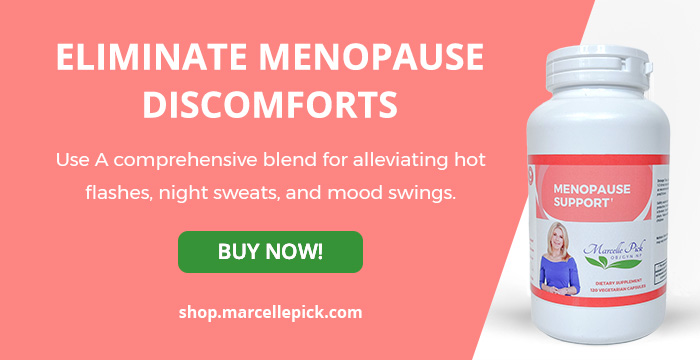A hormonal headache can stop you in your tracks, making it impossible to get anything done. That’s why it’s so important for women to understand where their hormonal headaches are coming from; you can’t find relief if you don’t treat the right problem!
So often, I have patients come to me after their conventional doctor has dismissed their hormonal symptoms as being “all in their head.” Often, the only solution they offer is a prescription for an antidepressant. But these women know they aren’t depressed. Their pain is real, and often hormones are at the root of the issue.
Headaches are a common reaction to hormonal fluctuations. Often, the pain coincides with their monthly rise and fall of estrogen and progesterone. But conventional practitioners – even those who specialize in headaches – often fail to consider hormones as one of the triggers. And when they do, they don’t have natural, long-term solutions to offer. They tell women they just have to learn to live with it each month, or they prescribe pain relievers, birth control pills or send these patients to their ob-gyn for consultation.
These women come to me disheartened and discouraged. They’re afraid they’ll never escape the head pain or will have to take prescription medication forever. But I’m happy to say that most of my patients happily report that their headaches are gone – or at least come far less frequently. And it’s because they address hormonal imbalance systemically. Their process includes a combination of diet and lifestyle changes, along with some short-term bioidentical hormone supplementation.
Women who have never had headaches often find themselves experiencing hormonal headaches or menstrual migraines as they enter perimenopause. I have been able to help these women find relief, but the answer isn’t as simple as a prescription. I take a holistic approach that not only provides headache relief but will boost your overall health as well! Let’s take a closer look at finding relief for hormonal headaches.
When Do Hormonal Headaches Hit?
Hormonal headaches often hit women who are sensitive to hormonal variability just before the onset of menses, when progesterone levels drop naturally. But these headaches can happen at other times too. They can happen at ovulation, when there is a rise in estrogen or other hormones, and even during menses, when estrogen and progesterone have hit their lowest point.
In perimenopause or at menopause, these hormonal headaches can begin abruptly, or be hard to predict, due to big shifts in a woman’s hormones. That’s why women who have never had a headache problem can suddenly find themselves battling head pain on a regular basis. One woman I know had debilitating headaches at menarche, but then went forty years with no issues. Then her headaches came back full force during her initial year of menopause. Every woman is unique; your body will tell you best when you need to seek natural treatment or prevention methods.
One of the first steps in dealing with headache pain is to pay close attention to when the pain begins. It definitely helps to better tune into the signals your body is sending you. I suggest using a journal to help you find triggers and patterns. If you are still menstruating, it’s helpful to also track the days of your period. All of this information can give you a better indication of how your own hormones rise and fall each month, and how they might connect to your headache pain.
Headaches are rarely caused by one single factor, and there may be a number of triggers at play. Hormones are certainly one piece of the puzzle. Improving the ratio of estrogen and progesterone can help any woman experiencing regular migraines or headaches. Let’s take a closer look at this relationship.
How Do Estrogen and Progesterone Impact Headaches?
Hormonal headaches are most often a result of imbalanced ratios in the levels of estrogen to progesterone. This could be associated with the natural dip in progesterone that happens just before menses. In some cases, the body may be experiencing true progesterone deficiency. But some women, particularly those in perimenopause or menopause, have ongoing low progesterone levels that require supplementation. You can’t diagnose this kind of deficiency accurately without a blood or saliva test.
The mid luteal stage of your menstrual cycle is the best time to test your progesterone levels. This usually happens after ovulation, around the 21st day of a typical 28-day cycle. Because cycles vary widely, this time frame could be different for you. There is some controversy around the simple saliva test, and some practitioners will recommend a more expensive blood test. I usually start with the saliva test, but both are available. My recommendation may also vary depending on a woman’s age or the intensity of her symptoms.
Analyzing Your Test Results
The results are fairly consistent in women of any age. “Baseline” progesterone levels look okay, but the estrogen to progesterone ratio is out of whack. While you can test your estrogen levels through a blood panel as well, most often what this means is that the level of estrogen is fine, but not lined up with the opposing progesterone level.
If you have headaches around ovulation, this could be reflecting a temporary imbalance manifesting as PMS symptoms, including breast tenderness and headaches. It’s possible this temporary state could take hold and linger throughout the entire luteal phase. However, it’s almost certain that if you ratio of progesterone to estrogen is off, you will have a range of uncomfortable physical symptoms. In susceptible women, these will include hormonal headaches or migraines.
So, what is it that throws the ratios off? There are several possible explanations. Perhaps your body easily converts progesterone into estrogen. Or you may be sensitive to increased environmental xenoestrogens and other endocrine disruptors which mimic estrogen in the body. If you determine that your headaches may have a hormonal component, you can take steps to find relief.
Natural Prevention of Hormonal Headaches
You can’t get rid of hormonal headaches until you deal directly with the imbalance – whether temporary or ongoing – in the estrogen to progesterone ratios.
I’ve said it before, and I’ll say it again – the first step is always a healthy, balanced diet. That means getting rid of – or at the very least strictly limiting – simple carbohydrates, refined sugars and processed foods. Take a look at my many articles on nutrition, including my nutritional and lifestyle guidelines, to get started.
We’re exposed to a lot of toxins in the environment, so the next step is to decrease exposure, and find a way to flush toxins your body is holding on to. You can get a good start on this by trying my two-week Quick Cleanse. Also, be aware of chemicals that could be disrupting your endocrine system and avoid them as much as possible. These chemicals can trigger migraines and lurk everywhere – in perfumes and beauty products, plastic food containers, even cash register receipts.
The third step is to boost your nutrient intake and fill any dietary gaps with nutritional supplements. But not just any supplements will do. Often, those you buy at the pharmacy or grocery store contain fillers, or simply aren’t what they say they are. Do your research and make sure your supplements are created in a reputable lab. Start with a high-quality multivitamin complex like my Multi Essentials, which includes more than 20 vital minerals and nutrients, including calcium and magnesium. Omega-3 fatty acids, like those in my EPA/DHA Support are another important component in supporting hormonal balance and reestablishing good estrogen-progesterone ratios. From there, you can consider a number of other nutritional supports. A moderate amount of soy, flaxseed (freshly ground), and foods high in fiber, isoflavones, fatty acids and lignan precursors can all be helpful.
Additional Relief for Hormonal Headaches
There are also some supplements that specifically target migraine prevention that can be quite helpful as well. Some herbs have been used by herbalists for thousands of years to prevent and treat headaches – and at least two of these, butterbur (Petasites hybridus) and feverfew (Tanacetum parthenium), have been verified as effective in clinical trials. Magnesium and vitamin B2 (riboflavin) have also been established to reduce frequency of migraines in people who typically have several per month by at least 50%. These natural ingredients can be found in some safe, over-the-counter migraine prevention formulas that are worth looking into. Migravent, for instance, has all four of these ingredients.
Other plant extracts that have a long history of use in different cultures to relieve headaches and other hormonal symptoms include soy, black cohosh (Cimicifuga racemosa) and dong quai (Angelica sinensis). I suggest you consult with a qualified practitioner before trying naturopathic remedies, to discuss what might work best in your specific circumstances. Often, making small changes in your diet, lifestyle, and nutrition intake can make a big difference!
After paying attention to core nutrition, you might discover that a natural hormone supplement at a particular time of the month can also provide relief. A low dose of a bioidentical progesterone cream, along with the other measures I’ve suggested, has freed many of my patients from hormonal headaches. It’s essential that you know how to use this natural progesterone supplement appropriately, so be sure to discuss with your practitioner. Some general guidelines based on when your hormonal headaches occur are below.
What You Can Do to Prevent Headaches Related to Your Birth Control Pill
I often have women tell me that their hormonal headaches appear on the second or third day of their placebo pills. I presume that these headaches are a lot like menstrual headaches, and they happen because of the rather abrupt drop in synthetic hormones that occurs during the placebo week of birth control pills.
Nutritional support is critical for all women, and those on synthetic birth control will certainly feel better if they are supporting their bodies in ways that will help them metabolize and clear those synthetic hormones. And this is also where the low-dose, bioidentical progesterone cream can offer support. I recommend using it on days 7-21 of each pill package, but it might also work well during the placebo phase. Another option is to try a bioidentical estradiol patch during the placebo week. All of these solutions are best worked through with your healthcare provider to be sure you find the one that’s right for you.
In severe cases, you could consider skipping the placebo phase altogether for a few months. This is not something I typically recommend, but it’s an option for women who struggle with changing their diet or lifestyle, or don’t want to try bioidentical progesterone. It works best when you are taking birth control pills that all contain the same dose, rather than those with a gradation of doses throughout the cycle. While you might encounter some unexpected bleeding, this method should protect you from pregnancy if you take your pills as directed.
One final option is to reduce the number of days that you are taking the placebo pills. Again, it’s essential that you discuss any of these choices with your healthcare practitioner before modifying your prescription.
Is Hormone Use Right for You?
Women are unique individuals, which is why I think it’s really important to begin treatment with my patients by asking how well they care for themselves. I want to know everything – medical and personal history, lifestyle, diet, and emotional considerations. That’s the best way for me to get a complete picture and help determine whether hormone use is appropriate.
I think that natural hormone supplementation is a powerful tool for some women, particularly when dealing with hormonal headaches. But hormones – even natural ones – are powerful, and shouldn’t be used lightly. I recommend a blood or saliva test first, especially if a woman is approaching menopause. And I believe that hormonal supplementation is a pathway to natural hormonal balance, not a long term solution.
A low dose of bioidentical progesterone, as detailed above, could be what your body needs to return to a more balanced estrogen-progesterone ratio without the need for further supplementation. I don’t suggest synthetic progestin use for headache or migraine relief, since they can cause your blood vessels to constrict, and might actually make headaches worse. Bioidentical progesterone, however, can be intuitively metabolized by your body.
As with any kind of medication – natural or not – you need to pay close attention to what your body tells you. If you experience an increase in symptoms while using bioidentical progesterone, you might have a natural tendency to convert extra progesterone into estrogen. In that case, adding progesterone might not be your best solution. If serious symptoms arise – such as unusual spotting, persistent heavy bleeding, or breast tenderness, you should stop using the progesterone and contact your healthcare provider immediately for further evaluation.
Quick Treatment for Hormonal Headaches
Awareness of patterns in your migraines or hormonal headaches allow you to take preventative measures to help reduce frequency. But even if you’ve developed healthier lifestyle and dietary habits, you might still get the occasional painful migraine. After all, we can’t avoid life stressors all the time! Treatment as early as possible will provide the best relief, but there are a few rescue remedies that you can have on hand. It’s best to use these sparingly and be sure to take as directed. And, as with any medication, don’t use without discussing your other prescriptions and lifestyle with your practitioner. For those emergency moments, here are a few options to help you feel better as quickly as possible.
NSAID’s
Early use of nonsteroidal anti-inflammatories (NSAID’s), at a dose best for you, can be very effective. I suggest ibuprofen (brand names Advil or Motrin) most often, taken with food. Keep the dosage at or below 800 mg every 4–6 hours (maximum of 2400 mg per 24-hours), and don’t use for more than two days in any given week (max is 2400 mg per 24-hour period). Some women also respond well to aspirin or Excedrin Migraine, a combination of acetaminophen, aspirin, and caffeine. Be sure you know potential side effects, especially if you are trying to conceive or pregnant. The only recommended NSAID for pregnant women is acetaminophen (brand name Tylenol).
Triptans
Triptans are believed to bind to serotonin receptors in the brain, constricting blood vessels and reducing inflammation. Some headache experts suggest that if you can identify a pattern of migraines on specific days in their cycle take a triptan once or twice a day to prevent onset of headaches. These are not approved by the FDA for this usage, but you can ask your headache specialist about this option. There are several different triptans, so if one doesn’t work, consider trying another formula. Be patient and you can find the best solution for you. Triptan use is not advised in pregnancy, and must be used very carefully if used in conjunction with an SSRI antidepressant.
Other Prescription Migraine Treatments
The website for the National Headache Foundation has a comprehensive list of migraine treatments used in conventional clinical settings. Often, these treatments were first used to address a different condition; high blood pressure, depression, and heart disease among others. But as it happens, they were incidentally found to stop acute migraine pain too. None should be used without careful medical supervision.
It is still safe to consider the natural measures described above, even if you are using these emergency measures on occasion. Because headaches occur as a result of many factors, I suggest you also read my article ten tips to prevent headaches naturally. All of these practices just make good health sense, and can help keep your body headache free without the use of a heavy-duty pain reliever.
Hormonal Balance Can Equal a Pain-Free Life
Pain of any kind is a signal from your body that something is off. Treating the pain might mask that signal, but it won’t make the problem disappear. Taking an integrative approach, and considering hormonal balance in your treatment plan can bring your body back into balance, relieving your symptoms for much longer than a pain reliever will. When hormones are behind your headaches, there are so many ways to address the issue in a proactive way. Nutrition, a healthy lifestyle, natural hormone support and proper supplementation can reduce how often – and how severe – your hormonal headaches are.
Relief won’t come overnight, and you may need to try a few interventions to find the right one. But be patient, because when you get there you just might be headache free – naturally!
Get the Support for Your Hormonal Imbalances
Because every woman’s body is different, you might find yourself in need of support to get you through periods of natural hormonal fluctuations. My Hormonal Quiz or PMS quiz can help you evaluate your needs and give you a starting point for discussion with your healthcare provider.
If you find you need a little extra support, I have some programs specifically designed to help you through crucial transitions.
- PMS Program. This comprehensive program is designed to help regulate menstrual cycles, balance hormones and reduce painful symptoms associated with PMS.
- Menopause Program. If you are approaching this pivotal time in your life, this program can help balance hormones and improve adrenal function to keep hot flashes, mood swings, poor sleep and brain fog at bay.
You can take control of your own hormonal imbalance instead of letting your hormones control your life. With a little natural support, you can find your way to a pain-free, happy, healthy life.
Note: Sudden severe, blinding pain with no prior history of migraines must be taken seriously. If you are having severe headaches, headaches with other sensory or neurological symptoms, or new or different headaches, seek help immediately at the nearest emergency department. Don’t Wait!









